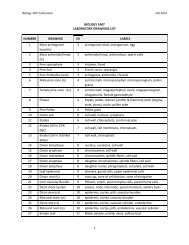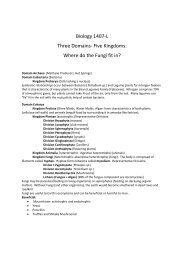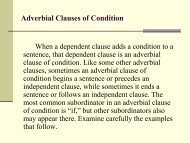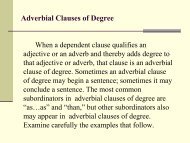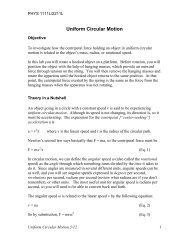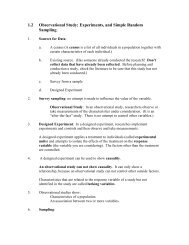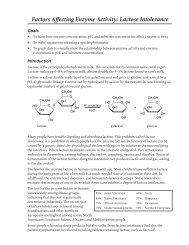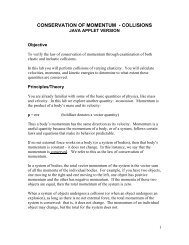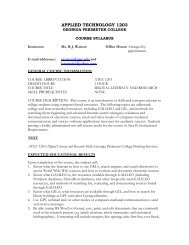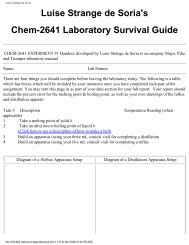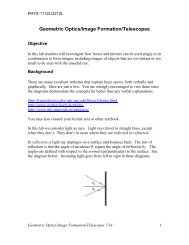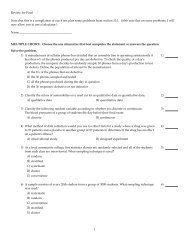3.2 Graphing Linear Equations in Two Variables
3.2 Graphing Linear Equations in Two Variables
3.2 Graphing Linear Equations in Two Variables
Create successful ePaper yourself
Turn your PDF publications into a flip-book with our unique Google optimized e-Paper software.
3. Method: Because two dist<strong>in</strong>ct po<strong>in</strong>ts determ<strong>in</strong>e a l<strong>in</strong>e, to graph a l<strong>in</strong>ear equation,<br />
plot any two dist<strong>in</strong>ct ordered pair solutions and connect them with a l<strong>in</strong>e. (Plot a<br />
third solution as a check.)<br />
4. Don't pick po<strong>in</strong>ts to graph that are too close together. (It would be hard to graph<br />
an accurate l<strong>in</strong>e.)<br />
5. Intercepts:<br />
a. The x-<strong>in</strong>tercept is the po<strong>in</strong>t where the graph crosses the x-axis.<br />
F<strong>in</strong>d the x-<strong>in</strong>tercept by plugg<strong>in</strong>g zero on for the y coord<strong>in</strong>ate and solv<strong>in</strong>g<br />
the result<strong>in</strong>g equation for x. (Let y = 0.)<br />
b. The y-<strong>in</strong>tercept is the po<strong>in</strong>t where the graph crosses the y-axis.<br />
F<strong>in</strong>d the y-<strong>in</strong>tercept by plugg<strong>in</strong>g zero on for the x coord<strong>in</strong>ate and solv<strong>in</strong>g<br />
the result<strong>in</strong>g equation for y. (Let x = 0.)<br />
6. L<strong>in</strong>es through the Orig<strong>in</strong>: If A and B are non-zero real numbers, the graph of<br />
a l<strong>in</strong>ear equation of the form<br />
Ax + By = 0<br />
passes through the orig<strong>in</strong> (0, 0). (Thus, to graph this type of l<strong>in</strong>ear equation, plot<br />
the po<strong>in</strong>t (0, 0), which is the x- and y- <strong>in</strong>tercept, and two other po<strong>in</strong>ts. The x- and<br />
y-<strong>in</strong>tercepts will not be enough to graph these l<strong>in</strong>es.)<br />
7. Horizontal L<strong>in</strong>e: A l<strong>in</strong>ear equation of the form y = b (or By + C = 0 ) has a<br />
graph given by a horizontal l<strong>in</strong>e through the po<strong>in</strong>t (0, b).<br />
8. Vertical L<strong>in</strong>e: A l<strong>in</strong>ear equation of the form x = a (or 1⋅ x + 0⋅ y = a) has a<br />
graph given by a vertical l<strong>in</strong>e through the po<strong>in</strong>t (a, 0).<br />
9. See the summary of l<strong>in</strong>ear equations on page 212.<br />
10. You can graph l<strong>in</strong>ear equations of the form Ax + By = C <strong>in</strong> a calculator by<br />
first solv<strong>in</strong>g for y. Enter the result<strong>in</strong>g expression <strong>in</strong>to one of the slots <strong>in</strong> the y=<br />
key. Hit the GRAPH key. Check that the w<strong>in</strong>dow shows the x- and y-<strong>in</strong>tercepts.<br />
If these <strong>in</strong>tercepts do not show <strong>in</strong> the w<strong>in</strong>dow, go to the WINDOW key and<br />
change the x and y ranges. (The Standard w<strong>in</strong>dow - #6 ZStandard <strong>in</strong> the ZOOM<br />
key is often a place to start.)



